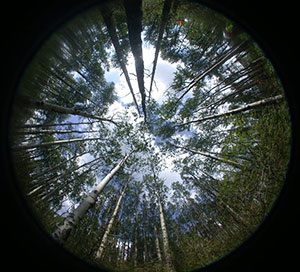University of Alberta Taps IBM Streaming Analytics Software for Climate Change Research

The view from a wireless optical sensor measuring continuous light interception in a boreal forest stand (Photo: University of Alberta)
Advanced analytics software from IBM is providing researchers at the University of Alberta in Canada a real-time view of carbon's impact on the environment.
The university's Enviro-Net project monitors climate change by collecting and analyzing sensor data on carbon levels, relative humidity, temperature, soil moisture, atmospheric pressure, ambient noise and other environmental indicators from forests in Canada, Australia, Brazil, Costa Rica and Mexico — a process that used to take months.
Now, using IBM's InfoSphere Streams software, researchers can ingest, correlate and analyze data in minutes, allowing them to detect, visualize and predict subtle environmental changes in real time. The software analyzes more than 10,000 data points per second from 500-plus sensors implanted in some of the world's most remote ecosystems.
The University of Alberta collaborated with IBM's T.J. Watson Laboratory to integrate the software into the research. According to a press release, "The technology provides researchers — and eventually policy makers — with an unprecedented ability to predict environmental events such as forest fires and drought, and to apply insights to more accurately forecast how boreal and tropical forests are returning after deforestation and disturbances." Going forward, the researchers plan to develop a simplified dashboard to make it easier to share the data and convey climate information to decision-makers.
"When I started this project four years ago I had no idea how much data I would be generating, and we could not look at our data in a reasonable amount of time. It was taking something like six months to two years before we had usable insights," said project leader Arturo Sanchez-Azofeifa, a professor and associate dean in the university's Department of Earth and Atmospheric Sciences. "Now, we can basically 'see' the forests breathing in real time."
About the Author
Rhea Kelly is editor in chief for Campus Technology, THE Journal, and Spaces4Learning. She can be reached at [email protected].